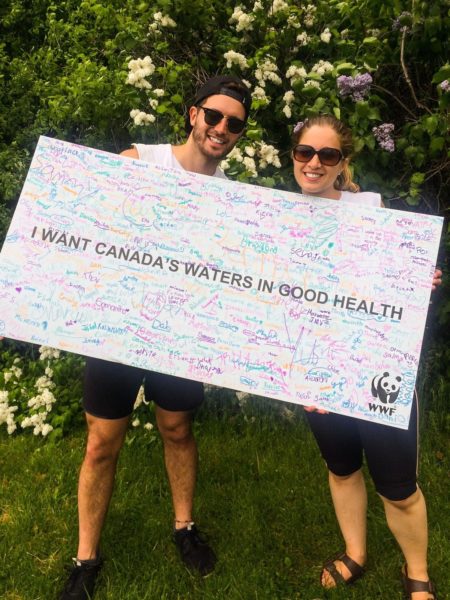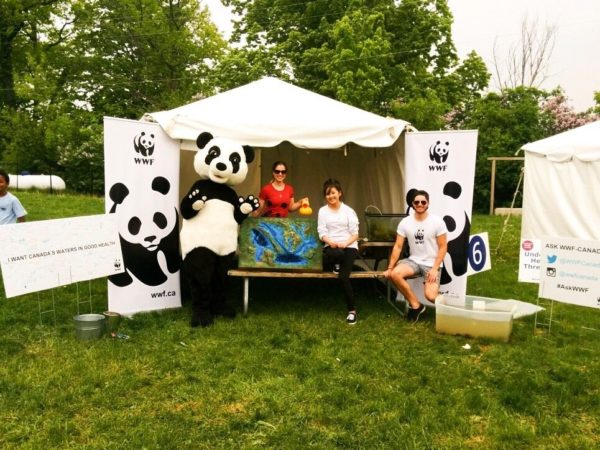Three questions kids had about freshwater
Written by Anthony Merante, Associate Specialist, Watershed Reports
Do all rivers end in lakes? How does a mussel eat? Why are river bottoms important? These are some of the questions students asked at the recent Peel Children’s Water Festival at Heart Lake Conservation Area in Brampton, Ont.
The two-day festival, organized by the Peel Environmental Education department, draws in almost 1,000 elementary school students per day. It brings in all aspects of water conservation, from household use to the water ecosystem biology.
WWF-Canada freshwater experts held interactive demonstrations of how rivers and lakes work featuring a model of a watershed that collected rain water. WWF-Canada also conducted a show and tell of live freshwater mussels to show students the different kinds of life in aquatic habitat. With appearances by our very own Panda mascot, students were excited to learn about freshwater ecosystems in Canada and take the pledge: “I Want Canada’s Waters in Good Health.”
Our pledge received hundreds of signatures and our Twitter feed came alive with questions from students about life under water.
Check out some of the most creative questions we had:
Why is the bottom of a river important? asked Jess, age 8,from Mississauga, Ont.
The bottom of a river or water body is referred to as the benthos, and all things living in the benthos are referred to as benthic. The bottom of a river is full of life and home to benthic invertebrates. Benthic invertebrates are organisms that do not have a backbone. Mussels, dragonfly larvae, crayfish, caddisfly larvae, mayfly larvae and Corixidae are a few of the hundreds of species that can occur in a single Canadian river.
These creatures are valuable parts of the aquatic food web and perform key functions in river health, such as natural water filtration. The presence or absence of specific species can guide us in knowing the health of the river itself. Each species of benthic invertebrate has a different tolerance to things such as organic pollutants. With long-term benthic invertebrate population monitoring, we can see trends of species shifting towards those that can withstand pollution or those that can’t. Knowing what is at the bottom of rivers, and what isn’t, provides us with powerful insight into aquatic ecosystem health. With this knowledge, we can adjust the way we manage water to help protect rivers and the animals inside of them. WWF-Canada uses benthic invertebrates as a metric of freshwater health assessment in the WWF-Canada Watershed Reports.
What do mussels eat and how do they eat? asked Sasha, age 11, from Brampton, Ont.
Mussels feed a little different than you and I, as they don’t have a mouth with a tongue or teeth. Freshwater mussels native to Ontario are suspension feeders, which means they extend their siphons (tube-like structures) into the water column to suck in bits of algae and water into their shell directly to their mouth, over their gills and into their stomachs. The algae they ingest is rich in nutrients and minerals that are used to help the mussels grow larger and stronger. Certain species can live up to 100 years old if the environment is healthy. Large threats to mussels include pollutants and the release of sediment with land use change in agriculturally intensive areas. Due to their sensitivity to these threats, as well as being out competed by invasive species, freshwater mussels are among the most endangered group of animals in North America.
Do all rivers go to lakes? says Sarah, age 9, from Caledon, Ont.
Not always, but let’s begin with where rivers start. A river can start from a natural spring or can be formed in mountains or hills from the collection of rain. A river usually starts off as small rifts that lead into each other, growing in size and flow with the addition of more water. These rivers can lead to lakes or they can lead to oceans. The opening of a river to a lake or ocean is called a river mouth. Sometimes a river carries large amounts of sediment down the river and creates a land form at the river mouth, called a delta. When a river and an ocean meet, we have the mixing of fresh water and salt water, creating an environment known as an estuary that some species have adapted to live in and can tolerate the changes in salt concentration.
To learn more about WWF-Canada’s freshwater work, visit wwf.ca/freshwater.




